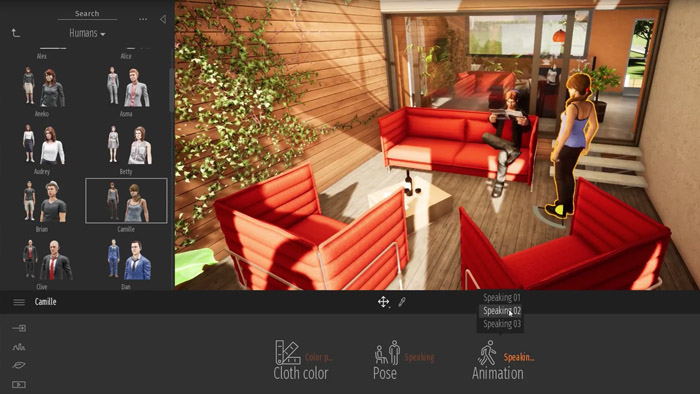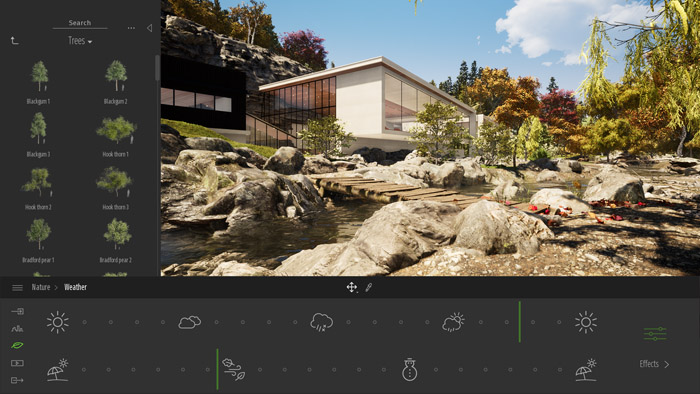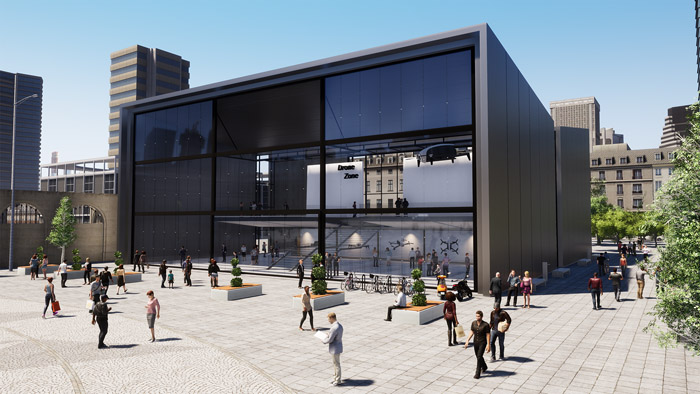Epic Games has acquired Twinmotion, an easy-to-use arch viz tool powered by Unreal Engine. This is big news in itself, as it gives the company exactly what it needs to get its powerful game engine technology into the hands of architects but, as Greg Corke explains, the even bigger news is, it’s giving it away for free.
Last year Epic Games made a huge play for the architectural visualisation market with the launch of Unreal Studio beta. And it sounds like it’s been a huge success. To date, it has attracted 250,000 subscribers and it’s still free to download until September 2019.
Unreal Studio solved many of the workflow issues faced by those using the powerful game engine to create arch viz experiences for desktop, mobile, AR and VR. “We’re taking all the ‘boring’ work out of the process and giving users more time to be creative,” said Marc Petit, Unreal Engine’s general manager at its launch in March 2018.
At the heart of Unreal Studio was Datasmith, a toolkit that allowed users to bring in Revit, SketchUp, Rhino, 3ds max and other CAD / BIM data, optimising and cleaning up geometry along the way. The FBX file format was no longer the only viable route in and, most importantly, Datasmith could also manage change. Users could import new revisions of BIM models and still maintain any investment they had made in their Unreal Engine scene.
All of this was great for design visualisers as it dramatically reduced the amount of work they needed to do. But Unreal Engine has a huge array of features and the interface can be bewildering to those used to traditional Windows applications. In short, it’s simply too complicated for your average architect – particularly when compared to architect friendly viz tools like Enscape, Lumion and LumenRT. Such tools offer optimised workflows from BIM software and, with relatively little effort, allow users to produce high quality visualisations with realistic materials, lighting, etc. and then to go into VR at the push of a button. While Unreal Engine is great for creating polished animations and fully interactive experiences for marketing and presentations, it’s much less suited to quick design validation than these applications are.
In our conversations with Petit throughout 2018 he maintained that the objective at Epic Games Enterprise was to make a tool that can be used by everybody, not just viz specialists. At the time we couldn’t quite work out how this would be achieved with Unreal Engine as it was, particularly as Simon Jones, director, Unreal Engine Enterprise, ruled out the introduction of multiple versions of the software, say one for architectural visualisation, another for auto design.
It turns out that the answer was right under our noses, in the form of a third-party product called Twinmotion. And today, Epic Games has acquired the software from its developer Abvent for an undisclosed fee. Amazingly, it is making the software completely free until November 2019.
Viz for architects
Twinmotion is a mature viz tool designed for architects and visualisers. The product has been out for over a decade (we reviewed version 2 in 2011) but over the last couple of years the developers have really stepped things up, introducing live links to Revit and ArchiCAD and swapping out the original real-time engine for Unreal Engine.
The workflow for architects is very slick. Simply click the “See in Twinmotion” button in Revit or ArchiCAD and the entire project is synchronised in Twinmotion in a few seconds. Once the data has been brought in, it’s easy to use and even novices are able to create compelling output with ease, including images, panoramas, videos and 360° videos.
Scenes can be brought to life with dynamic vegetation, characters and vehicles as well as lights that simulate real or artificial lighting. There are 600+ Physically-Based Rendering (PBR) materials and an object library that includes chairs, tables, furniture, street lights and street signs. There is also a phasing tool which comes with more than 90 construction objects, such as excavators and cranes, and allows you to view projects at different stages from ground breaking to final delivery.
Twinmotion also offers an easy route into VR with a push button workflow. Users can also share 3D scenes through self-executable BIMmotion files that allow clients to navigate projects in real time or in VR without having to have Twinmotion installed on their machine.
But arguably one of the most important features as far as Epic Games is concerned is that there will soon be a link between Twinmotion and Unreal Engine. This is a major step forward in its ambition to make Unreal Engine a hub for AEC data throughout the design process. It means an architect can start using viz from a very early stage for design validation or communication and then hand over the asset to a viz specialist for further development in Unreal Engine. This could be to improve visual quality, add interactions (such as opening doors or turning on lights) or for light baking, which pre-renders the scene in order to reduce the load on the GPU and improve 3D performance.


Free really does mean free
Epic Games has a long history of giving away software gratis. In the games market, Unreal Engine is completely free, and developers only pay royalties on games that they sell.
When Epic Games told us under embargo last week that it had some exciting news coming up for architects, we did predict this could be the acquisition of Twinmotion. What we didn’t see coming was that the software, which previously cost €1,650 a licence, would be given away for free.
Until November 2019 you can download Twinmotion 2019 on Mac or PC for no cost and then continue to use it for as a long as you like, ‘no strings attached’. This isn’t beta software or a cut down version often seen in promos like this; it’s a fully-featured software tool that has been available in the market for nearly a year.
If you’re an architect working in 3D, especially if you use Revit or ArchiCAD, you’d be crazy not to take up this offer, even if the software initially sits on a virtual shelf gathering dust.
But how long will Twinmotion 2019 remain useful? As one of the major attractions of the software is the way it works seamlessly with ArchiCAD and Revit, we wondered whether it would stop working to its full capabilities when architects upgrade to future versions of these BIM tools. Amazingly, the answer is no. Petit told us that the plan is to keep Twinmotion 2019 current with the latest CAD software releases. There really do appear to be no catches to this incredible time limited offer.
What next for Twinmotion?
Epic Games has big plans for Twinmotion and will accelerate development so (one would presume) those that take up the offer of the free software will see compelling reasons to upgrade to a paid version in the future.
“The Twinmotion team under the visionary leadership of Raphael Pierrat has done a fantastic job, it will continue to focus on Twinmotion,” said Petit. “We plan to accelerate the pace of development and grow the team, therefore pass the word, we’re hiring in Strasbourg! The team will naturally benefit from having a direct access to all of Epic Games’ resources.”
When asked about specifics, Petit remained fairly tight lipped, although he did confirm that there were plans for direct synchronisation with other CAD / BIM tools, such as SketchUp or Rhino.
We got a bit more out of Twinmotion’s Martin Krasemann in our September 2018 interview, although roadmaps could have changed since then. He said Nvidia RTX, the real time ray tracing technology, is expected to be in the next release in Summer 2019.



Twinmotion 2019 features a measurement tool, which could be considered very basic design review and Krasemann confirmed there were plans to increase this type of functionality. “We see a great interest in features for design and project review. You’re going to see more of that in the next release,” he said.
We wonder if this might make use of BIM data that is already retrieved during the direct synchronisation with ArchiCAD and Revit and made accessible inside Twinmotion under the Scenegraph panel.
In our previous discussions with Petit he talked about the huge potential for Unreal Engine in the AEC sector. He envisions it becoming part of design – an aggregation platform for colossal multi-disciplinary models with support for features like clash detection and collaborative design review taking advantage of the built-in multiplayer gaming capability.
“Right now, you aggregate in 3ds max and do a beautiful picture and aggregate in Navisworks to make all the decisions,” he said in our September 2018 interview. “People will soon realise they can do this in the same platform; it will generate a lot of saving.”
We now wondered if Twinmotion would become the foundation for a more advanced product like the one he described last year but Petit says Epic Games is looking to keep things simple. “We see Twinmotion as a very generic presentation and storytelling tool, we plan to keep the interface simple so that it can be learned in a few minutes like it is today,” he said. “More advanced engineering and analysis workflows belong to Unreal Studio as users can tap into our Blueprint visual scripting system and access to BIM metadata.”
Of course, development of a highly visual collaborative design tool doesn’t necessarily have to be done by Unreal’s Enterprise team. Epic Games is actively looking for third-party developers to bring industry-specific workflow expertise to the game engine.


Our thoughts
Twinmotion looks to be a perfect fit for Epic Games, supporting its ambition to make Unreal Engine an essential tool for the design process. Developing a tool like this from scratch would have taken years. Now Epic instantly has a mature architect-focused product to push out to market, plus a compelling message that any asset created in Twinmotion can then be developed further in Unreal Engine. The icing on the cake is that it’s currently completely free.
When most software developers acquire a commercial product, it’s expected to deliver revenue immediately. But Epic is playing the long game here. It’s happy to seed the market now with the prospect of even bigger returns in the future.
The timing of the deal is also critical as the AEC viz market hots up and key vendors make their moves.
Last year, Epic’s main competitor, Unity, signed a deal with Autodesk to help data flow more freely between select Autodesk products, including Revit and 3ds Max, and its real-time Unity 3D development platform, which offers similar capabilities to Unreal Engine. Unity’s Mark Schoennagel told AEC Magazine last month that the goal is to make an official announcement about the new app at Autodesk University London, 18-19 June 2019.
We don’t yet know details of Unity’s developments in this space, but as the company is working with Autodesk at source code level, we know there will be very tight integration with geometry, meta data and textures flowing easily. But the big question is, are there any plans to make the new offering architect friendly?
With Twinmotion, Epic Games certainly looks to have this covered. If you’re an architect using any kind of 3D CAD or BIM tool, on Mac or PC, we highly recommend you download it now and give it a go.
For more details, and to download Twinmotion, visit twinmotion.com.
Epic Games will be showing Twinmotion in the UK for the first time at NXT BLD in London on 11 June.
Ken Pimentel from Epic Games will also be presenting the company’s vision for the future and how the multiplayer game Fortnite will change how AEC works – think smart cities, collaboration and digital fabrication.
If you enjoyed this article, subscribe to AEC Magazine for FREE







